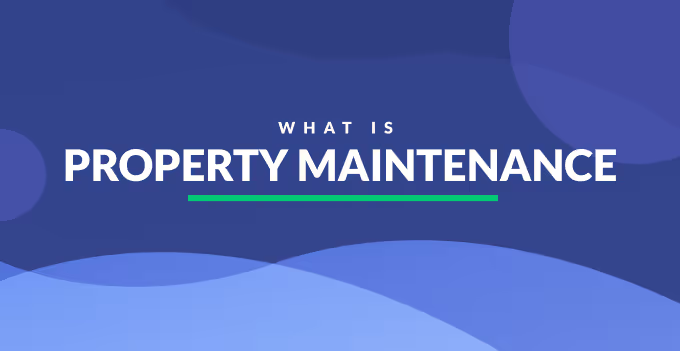As a landlord or property manager, there are so many things that you are responsible for.
From troublesome tenants to changing market conditions, property managers have a lot on their plate.
One of the most tedious things that property managers have to deal with is property maintenance.
Property maintenance can be a very complicated and headache-inducing task, which is where we come in.
In this guide, we will be explaining everything there is to know about rental property maintenance, including what it entails, why its important, and other important information.
To begin, let's go over a general definition of property maintenance.
What Is Rental Property Maintenance?
Rental property maintenance is the practice of maintaining various aspects of a rental property. This includes a plethora of different things.
Typically, there are three different types of maintenance: preventative, corrective, and routine. These three types of maintenance are incredibly important and each play a role in maintaining the rental property.
Below, we have briefly described these three different kinds of maintenance.
Routine Maintenance
Routine maintenance is the most common maintenance that will be done on a rental property with standard wear and tear. This maintenance includes things smaller things that can be done relatively quickly and easily, and on a routine basis. This could include landscaping, picking up trash, or other things around the property.
The maintenance cost of this rental maintenance is often very easy to calculate. There are even a lot of things that you can exclude from your budget, like changing the batteries on smoke detectors and carbon monoxide detectors. These are typically the tenant's responsibility, so you don't have to worry about them.
Preventative Maintenance
Preventative maintenance is another common form of maintenance that is done on a rental property. This kind of maintenance includes doing things like:
- Routine inspections
- Changing filters regularly
- Cleaning gutters
- Power washing
…and much more.
Although none of these are typically urgent and don't fix anything major, they are meant to prevent anything major from happening. This way, the landlords and property managers can save time and money by preventing larger, more expensive projects.
Corrective Maintenance
Corrective maintenance is a form of maintenance that is meant to correct something that was essentially unplanned. This kind of maintenance can be very expensive and come at any time.
To prevent the need for corrective maintenance, however, property managers use preventative maintenance. Preventative maintenance is much cheaper and easier and can prevent corrective maintenance from ever being needed.
Now that we have thrown out all of these terms, let's talk about some real-life examples of rental property maintenance that you will most likely see on your rental properties.
Property Maintenance Examples
Sometimes, it can be difficult to distinguish between maintenance that should be done by the tenant and that should be done by the landlord.
Below we have listed the most common examples of maintenance that the landlord is responsible for.
Painting and Flooring
One of the other things that are almost always the landlord's responsibility is revamping the paint and the flooring. Re-painting a property after a tenant leaves is an amazing way to increase tenant turnover. It is also one of the only options if the previous tenant left the walls in poor condition.
The flooring is also something that goes through tons of wear and tear as the years go by. Carpet floors are especially susceptible to damages and suffer the most compared to other types of flooring. In the case of carpet, the best course of action may be to get it cleaned every year by a professional.
Seasonal Rental Property Maintenance
Depending on the location of the rental property, a professional property manager may be responsible for handling seasonal maintenance. This could mean pruning trees, removing snow, or cleaning gutters.
It is also important to keep the lawn orderly and clean to prevent housing ticks, fleas, or rodents. This is oftentimes taken over by the tenant themselves, but can occasionally be part of the landlord's responsibilities.
Mechanical Systems
The mechanical systems of a property include plumbing, heating, electrical, and gas appliances. Although these systems typically undergo normal wear and tear, things like the water heater or a broken appliance may sometimes require replacement. When a replacement is required, the annual maintenance costs of a property can potentially skyrocket.
Structural Integrity
Another one of the landlord's most important maintenance responsibilities is making sure that the property is structurally sound. This means making sure that things such as the roof, the attic, sidewall, driveways, and walls are in good condition.
This is also one of the things that can severely drive up yearly maintenance costs. For this reason, it is suggested that landlords take preventative measures, like conducting routine inspections.
Now that we know about some of the common repairs landlords are responsible for, let's talk about why these repairs are so important.
Importance Of Property Maintenance
When it comes to maintenance on rental properties, it can be easy to see the immediate effects. However, what many people don't realize is that maintenance goes much further than just fixing something that is broken.
When a landlord conducts maintenance on a rental property, they are essentially investing in maintaining the property value. This means that they are investing in their own rental property income by conducting rental property maintenance.
So, apart from being a solid investment in your properties, maintenance is also required by law. And, if landlords do not comply with these laws, there can be various consequences, listed below.
Consequences of Not Performing Maintenance
Since maintenance has to do with the general wellbeing of the property and the tenant, there are some consequences associated with not doing it.
Below, we have listed some of the most common courses of action a tenant can take if maintenance isn't done. They are listed from the least severe to the most severe.
Withholding Rent Payments
Depending on your state's laws and regulations, the tenant may have the right to withhold rent payments from the landlord. This could happen in the case of the landlord not conducting a certain rental property repair the tenant requested.
Hiring a Third Party
If the landlord fails to perform the necessary rental property maintenance in a timely manner, the tenant may hire a third party to take care of it. This is usually the case if the tenant has provided proper notice to the landlord and has granted them ample time.
Constructive Eviction
Finally, if the lack of maintenance is persuasive and interferes with the tenant's right to live, the tenant may evict themselves. When this happens, the tenant moves out of the rental property and ends the lease agreement. Then, the tenant files a constructive eviction lawsuit against the landlord.
Not sure about your state's landlord-tenant laws and want to find out more? Visit DoorLoop's Real Estate Rental Laws page to learn everything about your state.
Now that we know all about the consequences of not keeping up with maintenance on your properties, let's go over the most common property maintenance repairs that are done on a property.
Rental Property Maintenance Costs
It is very easy to talk about all the things that need to be taken care of in a rental property. The hard part comes when it is time to pay for them.
This is when you would want to have a sound maintenance budget in place. Below, we will be going over some of the most useful rules to budget maintenance costs.
Also, assuming that any one of these rules will work perfectly for you is simply a rental property maintenance myth. It is important to analyze each rule and decide which one is best for you - or make your own!
Square Footage Formula
The next way to calculate your maintenance budget is by using a square footage formula. The square footage formula assigns a value of $1 to each square foot that your property covers and you set this much aside each year for maintenance.
For example, if your property is 1,500 square feet, you would set aside $1,500 each year for maintenance.
50% Rule
This is a very common rule used to plan out maintenance budgets for rental property maintenance. The rule stipulates that property managers, or property management companies, should devote 50% of their rental income to maintenance costs. Since this is typically a larger amount, it also goes towards taxes, insurance, utilities, etc.
For example, if you take home $1,500 a month in income, you would devote $750 every month to cover all of those expenses.
1% Rule
The 1% rule entails taking 1% of your total property value and setting that much aside for maintenance every year. For example, if your property is valued at $450,000, you should set aside $4,500 every year for rental property maintenance expenses.
The reason that this rule is effective is that there is a strong relationship between the value of your home and the cost of maintenance. Here, the relationship is that both factors depend on the price of materials and labor in your region. So, if house prices go up, so will the cost of maintenance.
Conclusion
In conclusion, maintenance is something that every landlord should be very wary of. There are so many benefits of being up to date with maintenance and many drawbacks to not paying much attention to it. Also, it's required by law in many states, so brush up on local and state laws to make sure you are in accordance.
Frequently Asked Quesitons
What Is Rental Property Maintenance?
Rental property maintenance is the practice of maintaining various aspects of a rental property to maintain its warranty of implied habitability.






.svg)
.svg)

